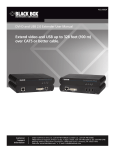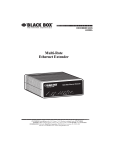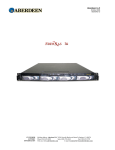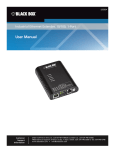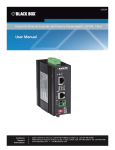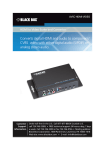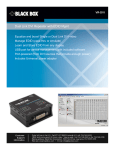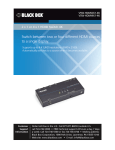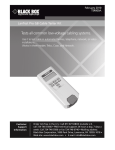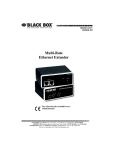Download Universal Fiber Optic Line Driver
Transcript
AUGUST 2003 MD650A-85 MD650A-13 Universal Fiber Optic Line Driver CUSTOMER SUPPORT INFORMATION Order toll-free in the U.S. 24 hours, 7 A.M. Monday to midnight Friday: 877-877-BBOX FREE technical support, 24 hours a day, 7 days a week: Call 724-746-5500 or fax 724-746-0746 Mail order: Black Box Corporation, 1000 Park Drive, Lawrence, PA 15055-1018 Web site: www.blackbox.com • E-mail: [email protected] MD650A-85 / MD650A-13 TRADEMARKS TRADEMARKS USED IN THIS MANUAL UL is a registered trademark of Underwriters Laboratories Incorporated. Any other trademarks used in this manual are acknowledged to be the property of the trademark owners. FCC STATEMENT FEDERAL COMMUNICATIONS COMMISSION AND CANADIAN DEPARTMENT OF COMMUNICATIONS RADIO FREQUENCY INTERFERENCE STATEMENTS This equipment generates, uses, and can radiate radio frequency energy and if not installed and used properly, that is, in strict accordance with the manufacturer’s instructions, may cause interference to radio communication. It has been tested and found to comply with the limits for a Class A computing device in accordance with the specifications in Subpart B of Part 15 of FCC rules, which are designed to provide reasonable protection against such interference when the equipment is operated in a commercial environment. Operation of this equipment in a residential area is likely to cause interference, in which case the user at his own expense will be required to take whatever measures may be necessary to correct the interference. Changes or modifications not expressly approved by the party responsible for compliance could void the user’s authority to operate the equipment. This digital apparatus does not exceed the Class A limits for radio noise emission from digital apparatus set out in the Radio Interference Regulation of the Canadian Department of Communications. Le présent appareil numérique n’émet pas de bruits radioélectriques dépassant les limites applicables aux appareils numériques de la classe A prescrites dans le Règlement sur le brouillage radioélectrique publié par le ministère des Communications du Canada. 1 MD650A-85 / MD650A-13 NOM STATEMENT Normas Oficiales Mexicanas (NOM) Electrical Safety Statement INSTRUCCIONES DE SEGURIDAD 1. Todas las instrucciones de seguridad y operación deberán ser leídas antes de que el aparato eléctrico sea operado. 2. Las instrucciones de seguridad y operación deberán ser guardadas para referencia futura. 3. Todas las advertencias en el aparato eléctrico y en sus instrucciones de operación deben ser respetadas. 4. Todas las instrucciones de operación y uso deben ser seguidas. 5.El aparato eléctrico no deberá ser usado cerca del agua—por ejemplo, cerca de la tina de baño, lavabo, sótano mojado o cerca de una alberca, etc. 6. El aparato eléctrico debe ser usado únicamente con carritos o pedestales que sean recomendados por el fabricante. 7. El aparato eléctrico debe ser montado a la pared o al techo sólo como sea recomendado por el fabricante. 8. Servicio—El usuario no debe intentar dar servicio al equipo eléctrico más allá a lo descrito en las instrucciones de operación. Todo otro servicio deberá ser referido a personal de servicio calificado. 9. El aparato eléctrico debe ser situado de tal manera que su posición no interfiera su uso. La colocación del aparato eléctrico sobre una cama, sofá, alfombra o superficie similar puede bloquea la ventilación, no se debe colocar en libreros o gabinetes que impidan el flujo de aire por los orificios de ventilación. 10. El equipo eléctrico deber ser situado fuera del alcance de fuentes de calor como radiadores, registros de calor, estufas u otros aparatos (incluyendo amplificadores) que producen calor. 2 MD650A-85 / MD650A-13 NOM STATEMENT 11. El aparato eléctrico deberá ser connectado a una fuente de poder sólo del tipo descrito en el instructivo de operación, o como se indique en el aparato. 12. Precaución debe ser tomada de tal manera que la tierra fisica y la polarización del equipo no sea eliminada. 13. Los cables de la fuente de poder deben ser guiados de tal manera que no sean pisados ni pellizcados por objetos colocados sobre o contra ellos, poniendo particular atención a los contactos y receptáculos donde salen del aparato. 14. El equipo eléctrico debe ser limpiado únicamente de acuerdo a las recomendaciones del fabricante. 15. En caso de existir, una antena externa deberá ser localizada lejos de las lineas de energia. 16. El cable de corriente deberá ser desconectado del cuando el equipo no sea usado por un largo periodo de tiempo. 17. Cuidado debe ser tomado de tal manera que objectos liquidos no sean derramados sobre la cubierta u orificios de ventilación. 18. Servicio por personal calificado deberá ser provisto cuando: A: El cable de poder o el contacto ha sido dañado; u B: Objectos han caído o líquido ha sido derramado dentro del aparato; o C: El aparato ha sido expuesto a la lluvia; o D: El aparato parece no operar normalmente o muestra un cambio en su desempeño; o E: El aparato ha sido tirado o su cubierta ha sido dañada. CE INFORMATION Standards to which conformity is declared: EN 55022 : 1998 3 MD650A-85 / MD650A-13 ITEMS INCLUDED Included with this product, you should have received: 1) 1 - MD650A-85 or MD650A-13 fiber optic line driver 2) 1 - Universal input AC power supply with 1 power connector 3) 1 - North American line cord 4) User’s Manual QUICK INSTALLATION GUIDE The following is a quick installation guide for the Universal Fiber Optic Line Driver. It is intended for users familiar with the installation of fiber optic transmission systems to get “up and running” in minimal time. Since these units are capable of being configured for operation in many different modes, we strongly suggested that you consult the appropriate sections of this manual. Optical Connectors Power Connector Power Indicator LED Signal Indicator LEDs Signal Connector For protocol and mode selection see User'sManual for proper DIP switch settings 4 MD650A-85 / MD650A-13 GENERAL INFORMATION Introduction: The Universal Fiber Optic Line Driver is fully compatible with EIA standards for RS-232, RS-422 and RS-485 at data rates from 0 (DC) to 2.1 mbps (200 kbps for RS232) in the low speed mode or from 10 kbps to 10 mbps in the high speed mode. It may be used for simplex or full duplex asynchronous transmissions in both point-to-point systems and drop-and-repeat data networks. It may also be used as a protocol converter. Although there are no operating controls, the user must configure the unit for the protocol, speed and mode of operation desired. Specifications: System Protocols*................................ EIA RS-232, RS-422, RS-485 2-wire or 4-wire System Data Rate*...............................Low speed: RS-232, DC-200 kbps, RS-422/485, DC to 2.1 mbps High speed: RS-422/485, 10 kbps to 10 mbps Modes of Operation*............................ Simplex, duplex, drop-and-repeat, Asynchronous, RTS or Data Derived T/R control Optical Loss Budget ............................ 62.5µ MM or 8/10µ SM Fiber 0-18 dB in low speed mode, 0-15dB in high speed mode Operating Wavelength.......................... 850 nm or 1310 nm Optical Connectors............................... ST (MM) Operating Temperature...................... -35 to +75 degrees C * Note that as provided from the factory, the universal data transceiver is set to the RS-232 point-topoint (200 kbps) and low speed modes of operation. In the low speed mode the unit will operate with all duty cycles including DC (logic 0 or logic 1 continuously). In the high speed mode of operation, the system will operate properly with all duty cycles from 50-50% to 70-30%. 5 MD650A-85 / MD650A-13 INSTALLATION Installation Procedure: There are no operating controls on the Universal Fiber Optic Line Driver. Simply set the mode of operation with the internal DIP switches and then connect the signal, power supply and fiber optic cables between the two units. 1. Connect the data processing equipment to be used to the 6 position terminal block on the transmission units. Refer to the signal and power connections section on page 7 for specifics. Be certain that the various connections are made properly. Also be sure to only use the positions called out for any particular protocol. 2. Set the internal DIP switches for the protocol, speed and mode of operation according to the instructions beginning on page 8. Note: As provided from the factory, the unit is set for RS-232, point-to-point. 3. Connect operating power. 4. Connect the two units together with two conductor fiber optic cable. Be certain that the “Transmit” connector of one unit is connected to the “Receive” connector of the other unit. 5. The system should now be operational. The transmitting element in the MD650A-13 uses a solid state Laser Diode located in the “Transmit” or “Tx” optical connector on the unit. This device emits invisible infrared electro-magnetic radiation which, if viewed at close range without a fiber optic cable connected to the optical connector, may be of sufficient intensity to cause instantaneous damage to the retina of the eye. As a result, direct viewing of this radiation should be avoided at all times. Signal and Power Connections: The power terminal block connections for the model 5012 are as follows: +10 to +18 VDC, position 2. DC return, position 1. Note that this input is also reverse-polarity protected. 6 MD650A-85 / MD650A-13 INSTALLATION RS-232 Signal Connections: Description EIA Designation Terminal Positions Chassis Ground/Common (AA) 1 Transmit Data (BA) (input) 2 Receive Data (BB) (output) 4 Signal Common (AB) 1 All other terminal block positions should not be connected for this format. RS-422 Signal Connections: Chassis Ground 1 Transmit Data (+) (input) 2 Transmit Data (-) (input) 3 Receive Data (+) (output) 4 Receive Data (-) (output) 5 All other terminal block positions should not be connected for this format. RS-485 2-Wire Signal Connections: Chassis Ground 1 Transmit/Receive Data (+) (input/output) 2 Transmit/Receive Data (-) (input/output) 3 RTS Enable (when used) (input) 6 All other terminal block positions should not be connected for this format. 7 MD650A-85 / MD650A-13 INSTALLATION RS-485 4-Wire Signal Connections: Chassis Ground Transmit Data (+) Transmit Data (-) Receive Data (+) Receive Data (-) RTS Enable (when used) (input) (input) (output) (output) (input) 1 2 3 4 5 6 All other terminal block positions should not be connected for this format. When the RTS mode of operation is used, the input to terminal 6 must be “high” for the unit to transmit data and “low” to receive data. Modes of Operation: The Universal Fiber Optic Line Driver has two internal DIP switches that are accessible on the bottom of the housing. These must be set to configure the desired mode of operation. Setting the MODE DIP switch For all protocols, positions 1 and 2 of the MODE DIP switch should be set as follows: · Low speed mode (DC to 2.1 mbps): · High speed mode (10 kbps to 10 mbps): Position 1 = ON, Position 2 = OFF Position 1 = OFF, Position 2 = ON For RS-232, the data rate is limited to 200 kbps. For RS-422/485, the data rate is as above. The universal data transceiver will not operate properly if positions 1 and 2 are both set to either ON or OFF. 8 MD650A-85 / MD650A-13 INSTALLATION Use the following protocol-specific settings to finish configuring the MODE DIP switch on your universal data transceiver. ____________ RS-232 Point-to-Point (Factory-Default Setting) · 8 position “MODE” DIP switch: 3 4 5 6 7 8 Off Off Off On Off Off · 6 position “T/R” DIP switch: All switches OFF ____________ RS-232 Drop-and-Repeat · 8 position “MODE” DIP switch: 3 4 5 6 7 8 Off Off Off On Off On · 6 position “T/R” DIP switch: All switches OFF When using this mode of operation, any RS-232 driver not transmitting data must be in the low or - voltage state as per EIA RS-232D. ____________ 9 MD650A-85 / MD650A-13 INSTALLATION RS-422 Point-to-Point · 8 position “MODE” DIP switch: 3 4 5 6 7 8 Off Off On On Off Off · 6 position “T/R” DIP switch: All switches OFF No end-of-line terminating resistors are provided. If required, they must be connected externally. ____________ RS-422 Drop-and-Repeat · 8 position “MODE” DIP switch: 3 4 5 6 7 8 Off Off On On Off On · 6 position “T/R” DIP switch: All switches OFF No end-of-line terminating resistors are provided. If required, they must be connected externally. In this mode, any RS-422 driver not transmitting data must be in the “low” state (terminal block position 2, negative with respect to position 3). ____________ RS-485 2-Wire Point-to-Point RTS Enable · 8 position “MODE” DIP switch: 3 4 5 6 7 8 On On On On On Off · 6 position “T/R” DIP switch: All switches OFF In this mode, the input to terminal 6 must be “high” for the unit to transmit data and “low” to receive data. No end-of-line terminating resistors are provided. If required, they must be connected externally. 10 MD650A-85 / MD650A-13 INSTALLATION RS-485 2-Wire Drop-and-Repeat RTS Enable · 8 position “MODE” DIP switch: 3 4 5 6 7 8 On On On On On On · 6 position “T/R” DIP switch: All switches OFF In this mode, the input to terminal 6 must be “high” for the unit to transmit data and “low” to receive data. No end-of-line terminating resistors are provided. If required, they must be connected externally. ____________ RS-485 2-Wire Point-to-Point Data Derived T/R · 8 position “MODE” DIP switch: 3 4 5 6 7 8 On On On Off On Off 6 position “T/R” DIP switch: Baud Rate T/R Time 1 2400 4.73 ms Off 4800 2.20 ms 9600 2 3 5 6 Off Off Off Off On Off Off Off Off On Off 1.10 ms Off Off Off On Off Off 19.2K 620 us Off Off On Off Off Off 38.4K 300 us Off On Off Off Off Off 57.6K 180 us On Off Off Off Off Off 76.8K 150 us On Off On On Off Off 115.2 K 110 us On On Off Off Off On 4 See next page 11 MD650A-85 / MD650A-13 INSTALLATION After transmitting the last data bit, the above settings will determine how long the transceiver continues to wait in the transmit mode for data before reverting to the receive state. The times specified are only recommendations but will be correct for most applications. If desired, they can be varied to meet specific data requirements. No end-of-line terminating resistors are provided. If required, they must be connected externally. ____________ RS-485 2-Wire Drop-and-Repeat Data Derived T/R · 8 position “MODE” DIP switch: 3 4 5 6 7 8 On On On Off On On · 6 position “T/R” DIP switch: Baud Rate T/R Time 1 2400 4.73 ms Off 4800 2.20 ms 9600 5 6 Off Off Off Off On Off Off Off Off On Off 1.10 ms Off Off Off On Off Off 19.2K 620 us Off Off On Off Off Off 38.4K 300 us Off On Off Off Off Off 57.6K 180 us On Off Off Off Off Off 76.8K 150 us On Off On On Off Off 115.2 K 110 us On On Off Off Off 12 2 3 On 4 MD650A-85 / MD650A-13 INSTALLATION After transmitting the last data bit, the above settings will determine how long the transceiver continues to wait in the transmit mode for data before reverting to the receive state. The times specified are only recommendations but will be correct for most applications. If desired, they can be varied to meet specific data requirements. No end-of-line terminating resistors are provided. If required, they must be connected externally. ____________ RS-485 4-Wire Point-to-Point RTS Enable · 8 position “MODE” DIP switch: 3 4 5 6 7 8 Off Off On On On Off · 6 position “T/R” DIP switch: All switches OFF In this mode, the input to terminal 6 must be “high” for the unit to transmit data and “low” to receive data. No end-of-line terminating resistors are provided. If required, they must be connected externally. RS-485 4-Wire Drop-and-Repeat RTS Enable · 8 position “MODE” DIP switch: 3 4 5 6 7 8 Off Off On On On On · 6 position “T/R” DIP switch: All switches OFF In this mode, the input to terminal 6 must be “high” for the unit to transmit data and “low” to receive data. No end-of-line terminating resistors are provided. If required, they must be connected externally. 13 MD650A-85 / MD650A-13 INSTALLATION RS-485 4-Wire Point-to-Point Data-Derived T/R · 8 position “MODE” DIP switch: 3 4 5 6 7 8 Off Off On Off Off Off · 6 position “T/R” DIP switch: Baud Rate T/R Time 1 2400 4.73 ms Off 4800 2.20 ms 9600 2 3 5 6 Off Off Off Off On Off Off Off Off On Off 1.10 ms Off Off Off On Off Off 19.2K 620 us Off Off On Off Off Off 38.4K 300 us Off On Off Off Off Off 57.6K 180 us On Off Off Off Off Off 76.8K 150 us On Off On On Off Off 115.2 K 110 us On On Off Off Off On 4 After transmitting the last data bit, the above settings will determine how long the transceiver continues to wait in the transmit mode for data before reverting to the receive state. The times specified are only recommendations but will be correct for most applications. If desired, they can be varied to meet specific data requirements. No end-of-line terminating resistors are provided. If required, they must be connected externally. 14 MD650A-85 / MD650A-13 INSTALLATION RS-485 4-Wire Drop-and-Repeat Data-Derived T/R · 8 position “MODE” DIP switch: 3 4 5 6 7 8 Off Off On Off Off On 4 5 6 · 6 position “T/R” DIP switch: Baud Rate T/R Time 1 2 3 2400 4.73 ms Off Off Off Off Off On 4800 2.20 ms Off Off Off Off On Off 9600 1.10 ms Off Off Off On Off Off 19.2K 620 us Off Off On Off Off Off 38.4K 300 us Off On Off Off Off Off 57.6K 180 us On Off Off Off Off Off 76.8K 150 us On Off On On Off Off 115.2 K 110 us On On Off Off Off On After transmitting the last data bit, the above settings will determine how long the transceiver continues to wait in the transmit mode for data before reverting to the receive state. The times specified are only recommendations but will be correct for most applications. If desired, they can be varied to meet specific data requirements. No end-of-line terminating resistors are provided. If required, they must be connected externally. 15 MD650A-85 / MD650A-13 INSTALLATION Optical Fiber: Versions of the Universal Fiber Optic Line Driver are available to drive most multimode (MM) and single-mode (SM) optical fibers. The specific models are identified as follows: Fiber Size Connector Model # Wavelength 50 or 62.5µ MM ST MD650A-85 850 nm 8/10 50µ SM ST MD650A-13 1310 nm Indicator LEDs: The Universal Fiber Optic Line Driver has three green signal indicator LEDs that continuously monitor operation. One, labeled “Power (or PWR)”, lights when operating power is present. The other two, labeled “Transmit (or Tx)” and “Receive (or Rx)”, turn on whenever the transmitted or received data is in the “high” state and off when it is in the “low” state. As a result, they actually blink at the rate of the operating data. However, most data rates are so fast that these LEDs will usually appear to be on continuously. 16 MD650A-85 / MD650A-13 CONFIGURING A RING OR LOOP-TYPE DATA BUS In addition to point-to-point transmissions, the Universal Fiber Optic Line Driver can be used to implement a ring or loop-type data bus. This is accomplished by setting the internal DIP switches as shown in the following diagram. Fiber Optic Cable Data Fiber Optic Transceiver To Host Computer Set to point-to-point mode of operation Fiber Optic Transceiver Fiber Optic Transceiver Fiber Optic Transceiver Drop 1 Drop 2 Drop 3 Set to drop-and repeat mode of operation Set to drop-and-repeat mode of operation Set to drop-and-repeat mode of operation Ring or Loop-type Data Bus Configuration When the Universal Fiber Optic Line Driver is used in this mode, any location can receive or insert data into the ring/loop but only one station at a time is permitted to insert data. All other stations will receive the data but must maintain their individual input lines in the low state (RS-232, terminal block position 2 negative with respect to position 1; RS-422, terminal block position 2, negative with respect to position 3) to prevent loop lock-up. RS-485 operation does not have the above restriction due to the fact that it is in the tri-state mode when not transmitting. Note that the first (or host) location is set to the point-to-point mode. All other locations are set to the drop-and-repeat mode. This is to prevent loop lock-up or data “echos”. 17 MD650A-85 / MD650A-13 OPERATING CONSIDERATIONS FOR FIBER OPTIC CABLE The Universal Fiber Optic Line Driver, as supplied, operates with most common fiber optic cables. However, it is important to use the correct type of fiber optic cable as required by your particular transceiver model. When using any type of fiber optic cable, be careful not to cause excessive strains, especially at the cable-to-connector junctions. Also, do not subject the cable to sharp bends or pull it around sharp corners. Whenever possible, service loops or extra slack should be provided in any installation. While excessive precautions are not necessary, fiber optic cable should be treated with moderate care as it does contain thin, fragile strands of glass. Notes Regarding Fiber Optic Cable: Multimode fiber optic cable contains an optical fiber with a light carrying “core” that is only .0025 inches (62.5µ) diameter. Single-mode fiber optic cable has an even smaller “core”, only 00032 to .0004 inches (8-10µ). This is smaller than a human hair! Any minute particle of dirt or dust can easily block this fiber from accepting or radiating light. As a result, the key word is cleanliness. Always use the dust caps provided with all optical connectors whenever they are exposed to air. Also, it is a good idea to gently clean the tip of an optical connector with alcohol whenever dust is suspected. Mechanical butt splices or optical feedthroughs must be installed properly. Multimode devices will not operate properly with single-mode devices even though they may look the same. Using the wrong device can easily add more attenuation than specified, resulting in impaired performance. TROUBLESHOOTING TECHNIQUES If your system is not operating properly, the following checklist may help to diagnose the problem: A. Check Transmitter or Transmit Section of a Transceiver 1. Is operating power (DC, AC, Voltages) correct? 2. Are you using the correct pins on the connector or terminal block? 18 MD650A-85 / MD650A-13 TROUBLESHOOTING TECHNIQUES 3. Is the correct signal level present at transmitter input? 4. Is the optical connector on the transmitting LED clear of any obstruction or minute dirt particles? 5. Is there a short circuit anywhere in the system due to common power ground, signal ground and case? * The above visual check should only be attempted with LEDs. NEVER LOOK DIRECTLY AT AN OPERATING LASER DIODE, REGARDLESS OF THE OF THE OPERATING WAVELENGTH!!! US Government regulations require that all equipment using Laser Diodes be clearly identified with warning labels. B. Check Optical Connectors 1. Are the connectors the correct size for the fiber? 2. Are the ends of the connectors free of all dust or dirt? If not, gently clean the tip of the connector with a clean cloth or gauze moistened with alcohol. 3. Is the fiber broken in the connector? A quick inspection with an inexpensive jeweler’s loop can determine this. 4. Is the fiber protruding from the tip of the connector? If so, refinishing will be necessary. C. Check Fiber Optic Cable 1. Is the fiber optic cable pulled too tightly around a sharp corner? 19 MD650A-85 / MD650A-13 TROUBLESHOOTING 2. Is the correct fiber size being used with the correct transmitter/ receiver combination? 3. Does the fiber pass light at all? A small penlight or flashlight can usually be used for this test. 4. Does the fiber have too much attenuation for the system? The attenuation measured on the installed cable will always be different than when the cable was still on the reel. 5. When using lengths shorter than 10 meters (30 feet), overloading of the receiver may occur. The shorter the length of the fiber, the greater the possibility for this condition. Be sure there is adequate attenuation in any system. For very short distances, contact the factory for assistance. D. Check Receiver or Receiving Section of a Transceiver Follow the same steps as for checking the Transmitter. However, instead of checking the LED for light, check the receiving end of the fiber optic cable. MAINTENANCE The Universal Fiber Optic Line Driver has been manufactured using the latest semiconductor devices and techniques that electronic technology has to offer. It has been designed for long, reliable, and trouble free service and is not normally field repairable. The only maintenance that can be provided by the user is to ascertain that optical connectors are free of dust or dirt that could interfere with light transmission and that electrical connections are secure and accurate. All other questions or comments should be directed to Black Box Tech Support. It should be noted that many “problems” can easily be solved by a simple telephone call. 20 © Copyright 2003. Black Box Corporation. All rights reserved. 1000 Park Drive • Lawrence, PA 15055-1018 • 724-746-5500 • Fax: 724-746-0746























